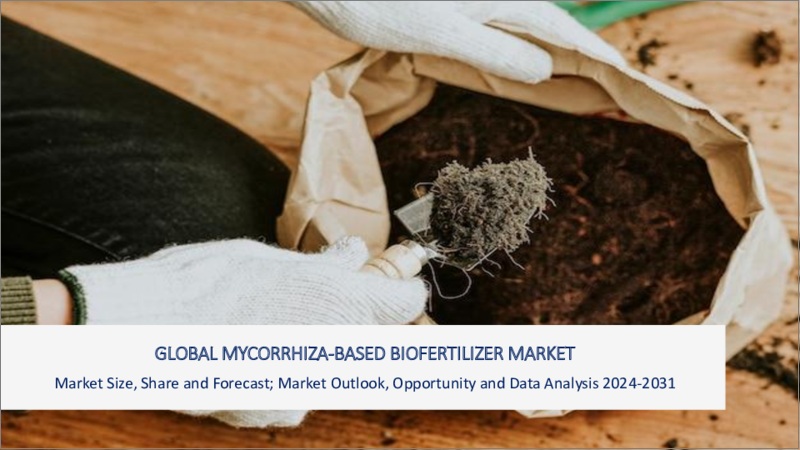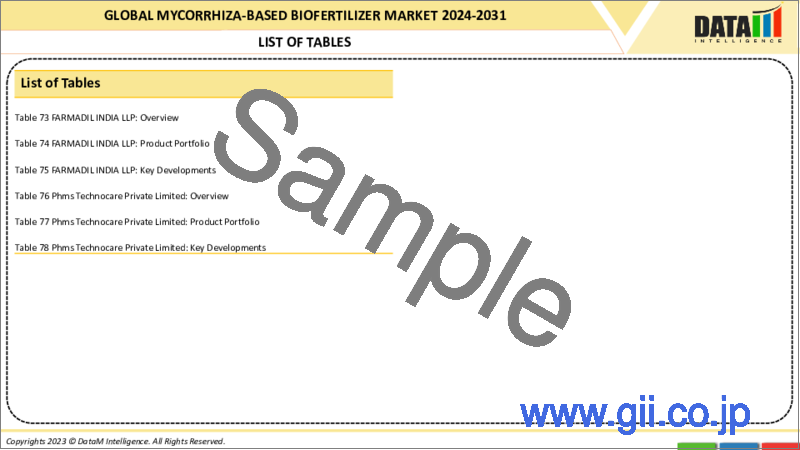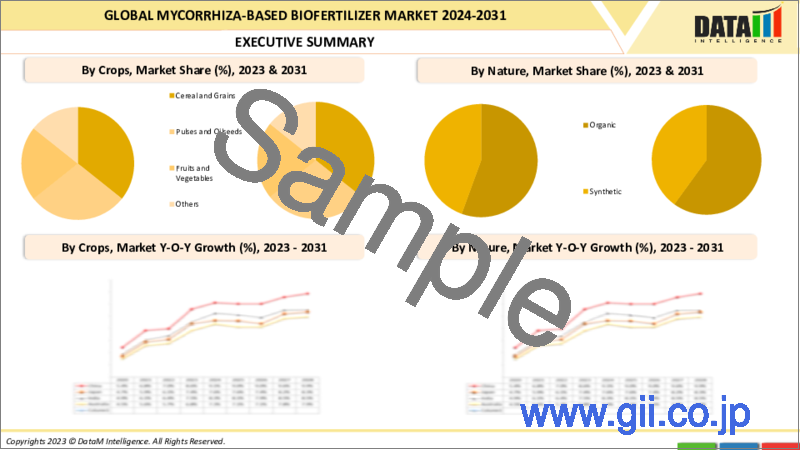|
|
市場調査レポート
商品コード
1146473
菌根ベースバイオ肥料の世界市場-2022-2029Global Mycorrhiza-based Biofertilizer Market - 2022-2029 |
||||||
|
● お客様のご希望に応じて、既存データの加工や未掲載情報(例:国別セグメント)の追加などの対応が可能です。 詳細はお問い合わせください。 |
|||||||
| 菌根ベースバイオ肥料の世界市場-2022-2029 |
|
出版日: 2022年10月31日
発行: DataM Intelligence
ページ情報: 英文 172 Pages
納期: 即日から翌営業日
|
- 全表示
- 概要
- 目次
市場力学
菌根ベースバイオ肥料の利点に関する農家の意識の高まりが市場成長を促進しています。
急速に拡大する有機食品市場は、菌根ベースバイオ肥料に高い需要を生み出しており、市場の成長を牽引しています。健康リスクの高まりや残留物・食品汚染のレベル上昇などの環境問題に対する消費者の意識が高まり、消費者は化学物質を含まない食品を好むようになっています。したがって、バイオ肥料や有機肥料は、有機農業の増加のために増加しています。例えば、FiBLによると、2020年の有機食品の世界市場は過去最高の伸びを示し、総額140億ユーロの増加で1200億ユーロを超えました。米国は引き続き主要市場(495億ユーロ)となっています。このように、持続可能な農業開拓への需要の高まりと、菌根を利用した生命力の強い作物の栽培の効率化が、最終的に市場の成長に拍車をかけているのです。
一方、市場の成長に影響を与える主な要因の1つは、食品汚染の高いリスクにつながる可能性がある菌根ベースバイオ肥料の限られた保存期間です。
地理的浸透
予測期間中はアジア太平洋が圧倒的な地域
2021年、アジア太平洋はYYパーセントの最も高い収益シェアを持っていました。この地域は、尿素肥料の需要を増加させ、市場の成長に追加する食品、工業、農業部門がよく発達しています。さらに、この地域には大規模な農業部門があり、肥料メーカーにとって重要な市場となっています。例えば、中国、インド、日本、韓国、台湾は、強力な農業生産部門を持つアジア太平洋地域の主要な国の一部です。したがって、一貫して成長している農業産業とそのために菌根ベースバイオ肥料の需要の増加は、この地域の市場の成長を推進しています。さらに、遺伝子組み換え作物の採用が増加し、農業部門の進歩がこの地域の市場の主要な促進要因となっています。
COVID-19の影響:世界の菌根ベースバイオ肥料市場にポジティブな影響
COVID-19の大流行により、閉鎖、営業停止、旅行禁止など、各国の経済に悪影響が及んでいます。農業は、サプライチェーンの制限や倉庫工場の閉鎖など、激しい混乱に見舞われた主要産業の1つです。COVID-19の大流行による世界の危機は、ほとんどの産業に大きな影響を及ぼしました。しかし、菌根ベースバイオ肥料市場を含む肥料業界は、この危機の中でサプライチェーンにある程度の回復力を示しました。肥料会社は長い間、激動する環境の中で働くことで、世界な免疫力を身に付けてきました。
さらに、各国政府はバイオ肥料メーカーを奨励するためのさまざまな制度を提供し、従来の農法から有機農法への移行をもたらすためにいくつかの取り組みを行っています。これらは、菌根バイオ肥料の使用を推進しています。食糧需要の増加と持続可能な市場開拓の必要性、重要作物の成長における目覚ましい効果、土壌中のリン酸レベルの枯渇が市場を牽引する要因となっています。このため、有機栽培の製品を求める傾向が強まっていることから、菌根メーカーはこれらのバイオ肥料に対する需要と供給のギャップを埋めるべく努力しています。
目次
第1章 調査手法と範囲
- 調査手法
- 市場の範囲
第2章 主な動向と発展
第3章 エグゼクティブサマリー
- 形態別市場内訳
- アプリケーションモード別市場内訳
- 作物タイプ別市場内訳
- 地域別市場内訳
第4章 市場力学
- 市場影響要因
- 促進要因
- 抑制要因
- ビジネスチャンス
- 影響分析
第5章 産業分析
- ポーターのファイブフォース分析
- バリューチェーン分析
- 規制分析
- サプライチェーン分析
第6章 COVID-19の分析
- COVID-19の市場分析
- COVID-19以前の市場シナリオ
- COVID-19の現在の市場シナリオ
- COVID-19の後、または将来のシナリオ
- COVID-19の中での価格ダイナミクス
- 需要-供給スペクトラム
- パンデミック時の市場に関連する政府の取り組み
- メーカーの戦略的取り組み
第7章 形状別
- 液剤
- キャリアベース
第8章 適用形態別
- 土壌処理
- 種子処理
第9章 作物タイプ別
- 穀物および穀類
- 豆類・油糧種子
- 果実・野菜
- その他
第10章 地域別
- 北米
- 米国
- カナダ
- メキシコ
- 南米
- ブラジル
- アルゼンチン
- その他の南米地域
- 欧州
- ドイツ
- 英国
- フランス
- スペイン
- イタリア
- その他の欧州地域
- アジア太平洋地域
- 中国
- インド
- 日本
- オーストラリア
- その他アジア太平洋地域
- 中東・アフリカ地域
第11章 競合情勢
- 競合シナリオ
- 競合の戦略分析
- 市況/シェア分析
- M&A(合併・買収)分析
第12章 企業プロファイル
- Novozymes
- 企業概要
- 製品ポートフォリオと説明
- 主なハイライト
- 財務概要
- Rizobacter
- UniCorp Biotech
- Symborg
- Valent Biosciences
- Asfertglobal
- Agrinos
- Sustane Natural Fertilizer
- Sikko Industries
- AgriLife
第13章 DataM
Market Overview
Mycorrhiza is a Bio-fertilizer that helps in promotion of plant growth in an environment friendly manner as well as providing several other benefits to cultivation of plants. It helps in promotion of plant growth in an environment friendly manner as well as providing several other benefits to cultivation of plants. Mycorrhiza is a Bio-fertilizer that helps promote plant growth in an environment-friendly manner and provides several benefits during the plant cultivation stages. Thus, owing rise in awareness about the benefits of mycorrhiza based biofertilizers its demand is increasing which is adding to the growth of the market.
The global mycorrhiza-based biofertilizer market was growing at a CAGR of 12.16% during the forecast period (2022-2029).
Market Dynamics: Increased awareness about the benefits of mycorrhiza-based biofertilizer among farmers is driving the growth of the market
The rapidly increasing organic food market is driving the growth of the market as it is creating high demand for mycorrhiza based biofertilizers. The increased consumer awareness of growing health risks and increasing levels of residues and food contamination and other environmental issues, consumers prefer to have chemical free food products. Thus, the biofertilizers and organic fertilizers has increased owing to increased organic farming. For instance, according to FiBL, the global market for organic food showed its highest growth ever in 2020, exceeding 120 billion euros - a total increase of 14 billion euros. The United States continued to be the leading market (49.5 billion euros). Thus, the market is driven by increasing demand for sustainable agriculture development and the efficiency of using mycorrhiza to grow vital grow crops which ultimately adds to the growth of the market.
On the other hand, one of the major factors affecting the growth of the market is the limited shelf life of mycorrhiza based biofertilizers that may lead to high risk of food contamination.
Market Segmentation: Liquid segment stands for the highest share in global mycorrhiza based biofertilizers
Liquid based fertilizers have been the most preferred choice of consumers due to the growing demand increased usage owing to its benefits such as easy way of usage, painless, fast-acting, immediate action after application.
Geographical Penetration: Asia-Pacific is the dominating region during the forecast period
The region has well-developed food, industrial and agricultural sectors which increases the demand for urea fertilizers and adds to the growth of the market. Furthermore, the region has a large agricultural sector which makes it an important market for fertilizer manufacturers. For example- China, India, Japan, South Korea and Taiwan are some of the major countries in Asia Pacific that have a strong agricultural production sector. Thus, the consistently growing agriculture industry and increased demand for mycorrhiza-based bio- fertilizers due to that is driving the growth of the market in the region. Furthermore, the advancements in agriculture sector along with increase in adoption of genetically modified crops are a key driver for the market in this region.
Competitive Landscape:
The global mycorrhiza-based biofertilizer market is competitive and comprises players such as Novozymes, Rizobacter, UniCorp Biotech, Symborg, Valent Biosciences, Asfertglobal, Agrinos, Sustane Natural Fertilizer, Sikko Industries and AgriLife among others. The mycorrhiza-based biofertilizer market competitiveness is estimated to increase over the forecast period as the key players focus on various strategies such as agreements and product innovation for various applications.
For instance,
- In February 2022, EuroChem Group AG, a, leading global fertilizer producer, acquired the nitrogen business of the Borealis group after having submitted a binding offer. This acquisition will provide EuroChem five production facilities across Europe as well as full sales and distribution network.
COVID-19 Impact: Positive impact on global mycorrhiza-based biofertilizer market:
The COVID-19 pandemic has adversely affected the economies of various countries due to lockdowns, business close, and travel bans. Agriculture is among the major industries that suffered from intense disruptions such as restrictions on the supply chain and the shutdown of warehouse plants. The global crisis caused by the COVID-19 pandemic exerted a significant impact on most industries. However, the fertilizer industry, including the mycorrhiza-based biofertilizer market, has shown some resilience in the supply chain during the crisis. Fertilizer companies have developed global immunity by working in a highly turbulent environment for a long time.
In addition, governments of different countries are providing various schemes for encouraging the manufacturers of biofertilizers, and they are taking several initiatives to bring about a shift from conventional farming practices to organic farming practices. These are driving the usage of mycorrhiza biofertilizers. Increased food demand and the need for sustainable agricultural development, impressive efficacy in the growth of important crops, and depleting phosphorous levels in soils are the factors driving the market. This, in turn, has led the mycorrhiza manufacturers to meet the demand-supply gap for these biofertilizers since there is a growing trend toward organic products.
The global mycorrhiza-based biofertilizer market report would provide an access to approximately 53 market data tables, 44 figures and 172 pages.
Table of Contents
1. Scope and Methodology
- 1.1. Research Methodology
- 1.2. Scope of the Market
2. Key Trends and Developments
3. Executive Summary
- 3.1. Market Snippet by Form
- 3.2. Market Snippet by Mode of Application
- 3.3. Market Snippet by Crop Type
- 3.4. Market Snippet by Region
4. Market Dynamics
- 4.1. Market impacting factors
- 4.1.1. Drivers
- 4.1.2. Restraints
- 4.1.3. Opportunities
- 4.2. Impact analysis
5. Industry Analysis
- 5.1. Porter's five forces analysis
- 5.2. Value chain analysis
- 5.3. Regulatory Analysis
- 5.4. Supply chain analysis
6. COVID-19 Analysis
- 6.1. Analysis of Covid-19 on the Market
- 6.1.1. Before COVID-19 Market Scenario
- 6.1.2. Present COVID-19 Market Scenario
- 6.1.3. After COVID-19 or Future Scenario
- 6.2. Pricing Dynamics Amid Covid-19
- 6.3. Demand-Supply Spectrum
- 6.4. Government Initiatives Related to the Market During Pandemic
- 6.5. Manufacturers Strategic Initiatives
7. By Form
- 7.1. Introduction
- 7.1.1. Market size analysis, and y-o-y growth analysis (%), By Form Segment
- 7.2. Market attractiveness index, By Form Segment
- 7.3. Liquid*
- 7.3.1. Introduction
- 7.3.2. Market Size Analysis, US$ Million, 2020-2029 And Y-O-Y Growth Analysis (%), 2021-2029
- 7.4. Carrier Based
8. By Mode of Application
- 8.1. Introduction
- 8.1.1. Market size analysis, and y-o-y growth analysis (%), By Mode of Application Segment
- 8.1.2. Market attractiveness index, By Mode of Application Segment
- 8.2. Soil Treatment*
- 8.2.1. Introduction
- 8.2.2. Market Size Analysis, US$ Million, 2020-2029 And Y-O-Y Growth Analysis (%), 2021-2029
- 8.3. Seed Treatment
9. By Crop Type
- 9.1. Introduction
- 9.1.1. Market size analysis, and y-o-y growth analysis (%), By Crop Type Segment
- 9.1.2. Market attractiveness index, By Crop Type Segment
- 9.2. Cereal and Grains*
- 9.2.1. Introduction
- 9.2.2. Market Size Analysis, US$ Million, 2020-2029 And Y-O-Y Growth Analysis (%), 2021-2029
- 9.3. Pulses and Oilseeds
- 9.4. Fruits and Vegetables
- 9.5. Others
10. By Region
- 10.1. Introduction
- 10.1.1. Market Size Analysis, And Y-O-Y Growth Analysis (%), By Region
- 10.1.2. Market Attractiveness Index, By Region
- 10.2. North America
- 10.2.1. Introduction
- 10.2.2. Key region-specific dynamics
- 10.2.3. Market Size Analysis, And Y-O-Y Growth Analysis (%), By Form
- 10.2.4. Market Size Analysis, And Y-O-Y Growth Analysis (%), By Mode of Application
- 10.2.5. Market Size Analysis, And Y-O-Y Growth Analysis (%), By Crop Type
- 10.2.6. Market Size Analysis, And Y-O-Y Growth Analysis (%), By Country
- 10.2.6.1. U.S.
- 10.2.6.2. Canada
- 10.2.6.3. Mexico
- 10.3. South America
- 10.3.1. Introduction
- 10.3.2. Key Region-Specific Dynamics
- 10.3.3. Market Size Analysis, And Y-O-Y Growth Analysis (%), By Form
- 10.3.4. Market Size Analysis, And Y-O-Y Growth Analysis (%), By Mode of Application
- 10.3.5. Market Size Analysis, And Y-O-Y Growth Analysis (%), By Crop Type
- 10.3.6. Market Size Analysis, And Y-O-Y Growth Analysis (%), By Country
- 10.3.6.1. Brazil
- 10.3.6.2. Argentina
- 10.3.6.3. Rest of South America
- 10.4. Europe
- 10.4.1. Introduction
- 10.4.2. Key Region-Specific Dynamics
- 10.4.3. Market Size Analysis, And Y-O-Y Growth Analysis (%), By Form
- 10.4.4. Market Size Analysis, And Y-O-Y Growth Analysis (%), By Mode of Application
- 10.4.5. Market Size Analysis, And Y-O-Y Growth Analysis (%), By Crop Type
- 10.4.6. Market Size Analysis, And Y-O-Y Growth Analysis (%), By Country
- 10.4.6.1. Germany
- 10.4.6.2. U.K.
- 10.4.6.3. France
- 10.4.6.4. Spain
- 10.4.6.5. Italy
- 10.4.6.6. Rest of Europe
- 10.5. Asia Pacific
- 10.5.1. Introduction
- 10.5.2. Key Region-Specific Dynamics
- 10.5.3. Market Size Analysis, And Y-O-Y Growth Analysis (%), By Form
- 10.5.4. Market Size Analysis, And Y-O-Y Growth Analysis (%), By Mode of Application
- 10.5.5. Market Size Analysis, And Y-O-Y Growth Analysis (%), By Crop Type
- 10.5.6. Market Size Analysis, And Y-O-Y Growth Analysis (%), By Country
- 10.5.6.1. China
- 10.5.6.2. India
- 10.5.6.3. Japan
- 10.5.6.4. Australia
- 10.5.6.5. Rest of Asia Pacific
- 10.6. Middle East and Africa
- 10.6.1. Introduction
- 10.6.2. Key Region-Specific Dynamics
- 10.6.3. Market Size Analysis, And Y-O-Y Growth Analysis (%), By Form
- 10.6.4. Market Size Analysis, And Y-O-Y Growth Analysis (%), By Mode of Application
- 10.6.5. Market Size Analysis, And Y-O-Y Growth Analysis (%), By Crop Type
11. Competitive Landscape
- 11.1. Competitive scenario
- 11.2. Competitor strategy analysis
- 11.3. Market positioning/share analysis
- 11.4. Mergers and acquisitions analysis
12. Company Profiles
- 12.1. Novozymes *
- 12.1.1. Company Overview
- 12.1.2. Product Portfolio and Description
- 12.1.3. Key Highlights
- 12.1.4. Financial Overview
- 12.2. Rizobacter
- 12.3. UniCorp Biotech
- 12.4. Symborg
- 12.5. Valent Biosciences
- 12.6. Asfertglobal
- 12.7. Agrinos
- 12.8. Sustane Natural Fertilizer
- 12.9. Sikko Industries
- 12.10. AgriLife
- List not Exhaustive*
13. DataM
- 13.1. Appendix
- 13.2. About us and services
- 13.3. Contact us




